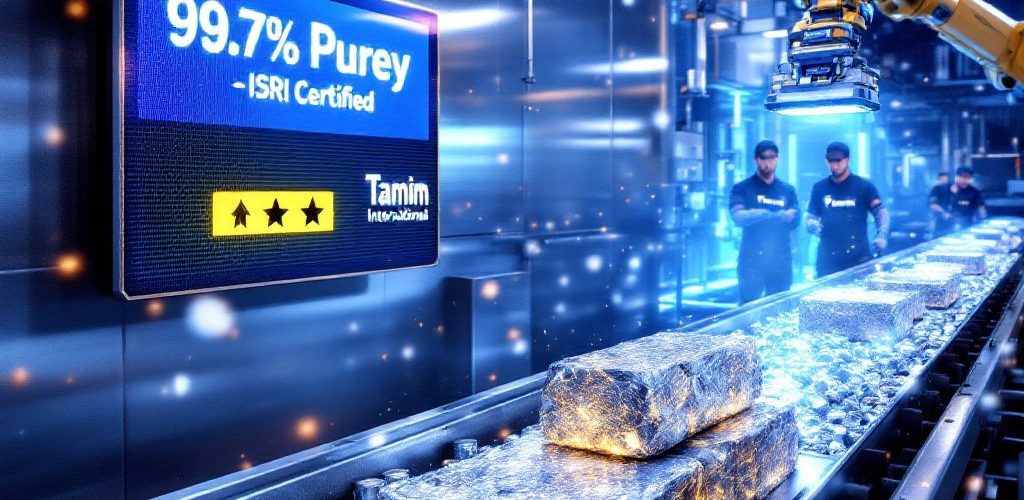Aluminum Scrap Recycling 2024: Cut Costs & Boost Sustainability | Tamim International
Aluminum Scrap Recycling; The global aluminum recycling market is projected to skyrocket to $95 billion by 2027, fueled by a 400% surge in demand for sustainable materials since 2020. As industries from automotive to aerospace pivot toward carbon neutrality, aluminum scrap recycling has transitioned from a cost-saving tactic to a strategic imperative. In 2024, B2B buyers face dual challenges: volatile scrap prices (+/- 25% YoY) and stringent ESG mandates. This guide dives deep into actionable strategies for sourcing ISRI-certified scrap, slashing costs by up to 40%, and aligning with circular economy principles—all while leveraging Tamim International’s zero-waste expertise.
Section 1: The Aluminum Scrap Recycling Revolution
1.1 Market Growth Drivers
- Automotive Lightweighting:
Electric vehicles (EVs) consume 200kg of aluminum per car, doubling traditional models. Tesla’s Cybertruck alone uses 900kg of recycled aluminum for its exoskeleton. - Aerospace Innovation:
Boeing’s 787 Dreamliner integrates 70% recycled aluminum in non-critical components, reducing weight by 15% and fuel costs by 12%. - Carbon Neutrality Goals:
Recycling aluminum emits 95% less CO2 than primary production, saving 200 million tons of greenhouse gases annually—equivalent to removing 45 million cars from roads.
1.2 Price Trends & Volatility
- 2024 Scrap Prices:
- UBC (Used Beverage Cans): 1,800–2,200/MT
- Extrusions: 1,500–1,900/MT
- Turnings/Shavings: 1,200–1,600/MT
- Key Volatility Factors:
- Energy Surcharges: European smelters add $150/MT due to natural gas price spikes.
- China’s Import Quotas: Restricted to 1.5MT in 2024 to prioritize domestic scrap.
Section 2: Sourcing High-Quality Scrap
2.1 ISRI Certification Essentials
- ISRI Guidelines:
- UBC: Clean, uncoated, iron/plastic-free, bulk density ≥50 lbs/ft³.
- Extrusions: Sorted by alloy (6061 vs. 6063), paint-free, and oxidation-free.
- Tamim’s Quality Control Protocol:
- XRF Testing: Instant alloy verification (e.g., 6063 = 0.2–0.6% Si, 0.45–0.9% Mg).
- Moisture Control: ≤2% moisture via infrared drying, preventing furnace explosions.
- Blockchain Traceability: Track scrap origin via IBM’s Hyperledger, ensuring OECD compliance.
2.2 Case Study: UAE Smelter Saves $500K Annually
- Challenge: A Dubai smelter faced 15% contamination in scrap, causing 3-day furnace shutdowns monthly.
- Solution: Tamim supplied ISRI-certified UBC and 6063 extrusions with real-time blockchain tracking.
- Result:
- 30% lower energy costs (reduced impurities = faster melting).
- Zero downtime and $500K annual savings.
Section 3: Cost-Saving Strategies
3.1 Bulk Buying vs. Spot Market
- Bulk Contracts (100+ MT):
- Lock prices for 6–12 months at 8% discounts.
- Example: A Turkish automaker saved $320K on a 1,000MT annual contract.
- Spot Market:
- Ideal for SMEs needing <50MT but risks 15–20% price swings (e.g., Q1 2024 saw UBC prices drop 18% in 30 days).
3.2 Advanced Logistics Hacks
- Container Optimization:
Use 40ft High-Cube containers for 25MT loads (vs. 20MT standard), cutting freight costs by $25/MT. - Nearshoring:
Source from GCC recyclers (e.g., Saudi Arabia’s Saudia Waste) to reduce transit time by 50% and freight costs by 35%. - Route Diversification:
Bypass Red Sea delays via the Cape of Good Hope, adding 10 days but avoiding $500/MT surcharges.
Section 4: Sustainability & Compliance
4.1 Global ESG Frameworks
- EU Taxonomy: Mandates 60% recycled content for “sustainable” aluminum by 2025.
- SEC Climate Rules: US-listed firms must disclose Scope 3 emissions (including scrap sourcing) by 2025.
- India’s EPR Policy: Extended Producer Responsibility requires 30% recycled content in packaging by 2026.
4.2 Tamim’s Zero-Waste Model
- Closed-Loop Process:
- Collection: Partner with 200+ global recyclers for ISRI-certified scrap.
- Processing: Shred, de-coat, and smelt into 99.7% pure ingots.
- Return: Deliver ingots to clients like BMW and Coca-Cola.
- Byproduct Monetization:
- Dross: Sold to cement firms as a kiln fuel additive ($120/MT profit).
- Slag: Repurposed into construction aggregates ($50/MT).
Section 5: The Future of Aluminum Recycling
5.1 AI & Automation
- AI Vision Systems:
Tomra’s Autosort® tech identifies alloys at 10 tons/hour with 99% accuracy, cutting labor costs by 40%. - Robotic Arms:
ABB’s YuMi robots sort UBC cans at 200 units/minute, reducing human error by 90%.
5.2 Green Financing & Incentives
- Sustainability-Linked Loans:
HSBC offers 0.5% lower rates for ISRI-certified buyers. - Carbon Credits:
Earn $15/ton of CO2 saved via platforms like Verra or Gold Standard.
Section 6: Common Pitfalls & How to Avoid Them
- Pitfall 1: Buying unverified scrap.
- Solution: Demand XRF reports and blockchain traceability.
- Pitfall 2: Ignoring moisture content.
- Solution: Use Tamim’s infrared drying pre-shipment.
- Pitfall 3: Overlooking regional tariffs.
- Solution: Leverage Tamim’s COMESA/EAC certifications for duty-free African trade.
Conclusion
In 2024, aluminum scrap recycling isn’t just eco-friendly—it’s a profit multiplier. By partnering with Tamim International, B2B buyers gain access to ISRI-certified scrap, AI-driven logistics, and ESG-compliant supply chains. Whether you’re a smelter, OEM, or recycler, the future of aluminum is circular—and it starts here.
Ready to Transform Your Supply Chain?
📞 Contact Tamim: Contact@tamiminternational.com
📥 Download Free Resources:
Are you looking for a reliable Aluminum Scrap Exporters?
Buy Aluminum online from Tamim International
aluminum scrap buyers, ISRI-certified recycling, circular economy metals, aerospace-grade aluminum, zero-waste refining, ESG compliance 2024


